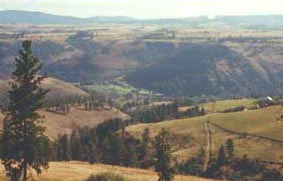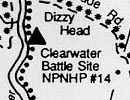

The Clearwater Battlefield is interpreted at a roadside pullout on the west side of Idaho Highway 13, approximately 2 miles south of Stites, Idaho. The battle site itself is located on private property, making it inaccesssible to the public.

On July 11, General Howard's command was riding from south to north along Battle Ridge, on the east side of the river. Because of the steepness of the bluffs, no one saw the Nez Perce camp directly below them until one of Howard's aides, Lieutenant Fletcher, happened to ride away from the main column in order to survey the view. He discovered the large encampment of the nontreaty Nez Perce on Cottonwood Creek. A cannon was brought into position and aimed at the village. While some of the Nez Perce men were racing their horses on the bench above the river, the cannon was fired at them.
Despite the surprise, the Nez Perce warriors took offensive action within minutes.
I saw soldiers strung out a long way off, far up along the mountain's brow... The chiefs called an order, "Split up! Make three bodies!'
About twenty of us young warriors joined together Chief Toohoolhoolzote was our leader. The other two companies must stay at camp. We hastened upriver a short ways. We crossed and rode into the timber. We hurried up the wooded slope of a canyon, leading to south side of this battlefield.
Yellow Wolf
Amazingly, the warriors quickly traveled up to the top of the ridge where the battle happened.
Our command numbered 400, and Joseph had 300 brave and determined warriors. The fighting was carried on very carefully on both sides. The Indians fought in a recumbent position and kept up a steady fire from behind rocks, trees, and every advantageous rise in the ground, like skirmishers and sharp shooters. Our men were forced to approach through open table land and received a galling fire.
Helena Herald
July 16, 1877
At one point of the line, one man, raising his head too high, was shot through the brain; another soldier, lying on his back and trying to get the last few drops of warm water from his canteen, was robbed of the water by a bullet taking off the canteen's neck while it was at his lips. An officer, holding up his arm, was shot through the wrist,, another, jumping to his feet for an instant, fell with a bullet through the breast. So all day long under the hot July sun, without water and without food, our men crawled about in the parched grass, shooting and being shot.
Lt. C.E.S. Wood
During the first day's fighting, there were four Indians killed and four wounded.
Duncan McDonald
The greatest torture for the soldiers on the first day of fighting was being cut off from water.
Still at night our position was not a very good one as the enemy lay contiguous to my communications and I was short of rations. This morning we began operations by regaining our spring of water from several sharp shooters....
Gen. Oliver Otis Howard
July 12, 1877
The day-and-a-half-long fight was unique. According to seasoned Indian fighters, Native American strategy usually involved a quick strike and withdrawal; an ongoing battle of this duration was relatively rare. A smoking lodge was the council headquarters for the Nez Perce. More and more warriors began spending time at the smoking lodge, leaving fewer and fewer warriors on the front line.
The fight was quit for a reason!
Wahchumyus [Rainbow], Pahkatos [Five Wounds], Teeweeyownah [Over the Point], Sarpsis lippilp [Red Moccasin Tops], Wahlitit5 [Shore Crossing], and Tipyahlanah Kapskaps [Strong Eagle] were in one place. Teeweeyownah said to us older men, "Get ready! Let the young men mount their horses! We will go mix the soldiers! We will make a desperate fight!'
But there were cowards who refused....
Teeweeyownah then said to the brave men, "Let us quit the fight!' Then he turned to the other men and spoke to them, "You cowards! I will die soon! You will see hardships in bondage. You will have a hard time. Your freedom will be gone. Your liberty robbed from you. You will be slaves!"
The leaders then left the fighting, the cowards then following after. I did not know this and was left behind. -1 could hear shots from but one gun and I hurried to see what was wrong. I found only Yellow Wolf, all others gone. It was his rifle I heard. I called him, then thought to save myself.
Wottolen
(Hair Combed Over Eyes)
The battle continued some hours. it must have been about ten o'clock, and soldier bullets still rained. Of course there was some cannon shooting. The soldiers began leaving their shelters, coming towards us.
Suddenly I heard my partner, Wottolen, call to me: "'Nobody here! We will quit!'
I raised partly up. No Indians could be seen fighting. AII had left the battle! Wottolen and myself were holding back the troops.
I now understood why soldiers crowded so. No warriors opposing them!
AII yesterday fighting; all this morning they did not crowd us. But now, meeting no Indian bullets, they came charging bravely.
Yellow Wolf
Dizzy Head is the name of the peninsula of exposed basalt just east of the turnout. A local story tells of a warrior racing down the hillside toward Dizzy Head chased by troops who were sure he was cornered. At the last minute he veered, rode down the side of Dizzy Head and escaped. Supposedly, the long dark streaks on the hill above the road were made by warriors sliding down the talus slope to join the fleeing tribe.
For a few minutes there is stubborn resistance at the enemy's barricades. Then the whole line gives way Immediately the pursuit is taken up by the infantry and artillery... and the remaining cavalry as soon as they can saddle and mount...
They are closely pursued through the ravines into the deep cation, thence to the river, over rocks, down precipices, and along trails almost too steep and craggy to traverse. The footmen pursued them to the river opposite the Indian camp. The river being too deep and rapid for the men to ford, they here awaited the cavalry...
The cavalry worked its way as rapidly as it could from its position on the left down the rugged mountain steeps to the deep ford, and crossed slowly into the Indian camp ... while ... the Indians ... were fleeing in every direction up the heights to the left of Cottonwood Creek and beyond the Clearwater.
Gen. O.O. Howard
August 27, 1877
While surveying was being done for the Stites Grade Road in the early 1900s, a dead soldier with several canteens was found in this ravine.
A spring in a ravine was secured, but one man sent to fill canteens never returned, and it was found that the enemy were in possession of it. Next day, however, the spring was retaken.
Lt. C.E.S. Wood
The Indian camp appeared to have been their home for a long long time. The order was, "Bum everything!" The packers and citizens (for it was marvelous how many citizens seemed to arrive), showed us how to find the caches or underground storages, by prodding with our ramrods. It was a wonder to see tons and tons of flour and other goods, and fine Indian goods, mostly burned. There was gold dust jewelry, and fine silver tableware, some of which I judged dated from an early Hudson's Bay period. AII this being brought to light, the packers and citizens helped themselves....
Lt. Harry L. Bailey
The Nez Perce had been driven from the battlefield and had fled their camp. However, the price of the military victory was quadruple the number of Nez Perce dead and wounded.
On the evening of the 12th I was left on the battlefield to gather the dead lost by our side. We found eight bodies and buried them near about.
... There were twenty-five wounded to take charge of and guard to Grangeville, Idaho Territory. While en route, three of the wounded died.
Capt. Robert Pollock
July 17, 1877
The soldiers stayed at the Nez Perce camp that night, continuing their plunder. The next morning, they again picked up the trail of the Nez Perce and headed to Kamiah.